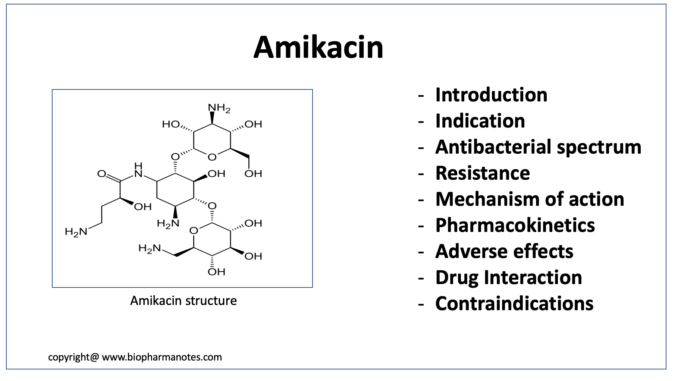
- Amikacin belongs to class of drug called aminoglycoside antibiotics. Aminoglycosides are important group of antibiotics which act against gram-negative bacteria. The name ‘aminoglycoside’ is given as the structure consist of 2 amino sugars joined by glycosidic linkage to central hexose nucleus.
- Amikacin is semi-synthetic aminoglycoside antibiotic derived from Kanamycin. Its introduction has replaced the use of kanamycin. Amikacin is also included in World Health Organization’s List of Essential Medicines.
- It has broader antibacterial spectrum compared to gentamicin, tobramycin and kanamycin.
Indications of amikacin
- Used in short term treatment of serious bacterial infections caused by gram negative bacteria. It is used mostly in combination with other antibiotics and is rarely used alone.
- To treat bacterial septicemia (including neonatal sepsis), serious respiratory, bone and joint infection.
- To treat intra-abdominal infection (including peritonitis), skin and soft tissue infection and infection of central nervous system (including meningitis).
- Also used in burns and post-operative infection.
Antibacterial spectrum
- Amikacin has activity against more resistant gram-negative bacteria such as P. aeruginosa and Acinetobacter baumanii. It is also active against most of the aerobic gram-negative bacteria from Enterobacteriaceae family, Proteus, Serratia, Klebsiella etc.
- When it is used in combination with carbapenems, it shows synergistic effect on some gram-positive bacteria. When combined with penicillin, it has additive action on some specific microorganisms.
- It is also effective against gentamicin and tobramycin resistant bacteria as its inactivation by bacterial acetylase, phosphorylase and adenylase.
Resistance
- Resistance to amikacin may develop due to acetylation by the aminoglycoside 6′-N-acetyltransferase type Ib [AAC(6′)-Ib], which is an enzyme coded by a gene found in integrins, transposons, plasmids, and chromosomes of Gram-negative bacteria.
Mechanism of action of amikacin

Figure- Mechanism of action of amikacin and other aminoglycosides (Source- Lippincott’s illustrated Reviews)
- Amikacin and other aminoglycoside antibiotics diffuse through porin channels of gram-negative bacteria and enter periplasmic space. Once inside the cell, they bind to 30S ribosomal subunit and interfere with protein synthesis initiation, block translation of m-RNA and prematurely terminate the synthesis of protein. This results in production of toxic or non-functional proteins and disruption of normal protein synthesis.
Pharmacokinetics of amikacin
- It can be administered via parenteral route (IV mostly). It can also be administered via IM or intrathecal route. Intrathecal route is used in patients with meningitis. Its liposome inhalation suspension form got approval in September 2018 for treatment of lung disease caused by Mycobacterium Avium complex. For this use, it is inhaled using a nebulizer for 14-20 minutes.
- It undergoes rapid absorption after IM administration and from pleura and peritoneum. Oral or topical absorption is poor. It gets distributed in bone, heart, gall bladder, synovial fluid, bronchial secretions, pleural and interstitial fluid. Binding with proteins is very less (around 10%).
- Most of the drug administered undergoes excretion via renal route. Its clearance decreases in patients with renal impairment. Hence, dosage adjustment is required in such patients.
Adverse effects
- Its most common and severe adverse effect is nephrotoxicity. The risk of nephrotoxicity is more in patients with low glomerular filtration rate, fever, sepsis, or diabetes. This effect is reversible after discontinuation of drug.
- When used in high dosage, it can cause ototoxicity, auditory and vestibular damage. Usage of drug for long time can led to permanent hearing loss. It can also cause neuromuscular blockade.
- Some other affects include rashes, fever, increase in BUN/Cr and neurotoxic effect.
Contraindications
- Contraindicated in patients hypersensitive to amikacin or any other aminoglycoside antibiotics.
- Not used in pregnant women as it can cause congenital deafness in infants, women who are breastfeeding and in infants.
- Patients on amikacin therapy should be continuously monitored for renal function and hearing parameter.
- It should be used with caution in elderly patients and in patients with impaired renal function.
Drug Interactions
- Concurrent administration with drugs which has nephrotoxic and ototoxic effects like cisplatin, vancomycin, amphotericin B, acyclovir, loop diuretics etc. may increase its risk of nephrotoxicity and hearing loss. Hence, this combination is not preferred.
- When used together with drugs like NSAIDS and quinidine which increase concentration of amikacin in blood, there is increased risk of renal damage. Concurrent administration with neuromuscular blocking agents can prolong muscle weakness and paralysis. Drugs like clindamycin, chloramphenicol and tetracycline can cause inactivation of amikacin.
References
- https://www.ncbi.nlm.nih.gov/books/NBK430908/
- https://www.sciencedirect.com/science/article/pii/B9780080552323612103
- https://go.drugbank.com/drugs/DB00479
- Ramirez MS etal. Amikacin: Uses, Resistance, and Prospects for Inhibition. Molecules. 2017 Dec; 22(12): 2267.
- Pharmacology and Pharmacotherapeutics. 24th edition.
- Goodman and Gillman Manual of Pharmacology and Therapeutics.
- Lippincott Illustrated Reviews Pharmacology, 6th edition.
- A textbook of clinical pharmacology and therapeutics.